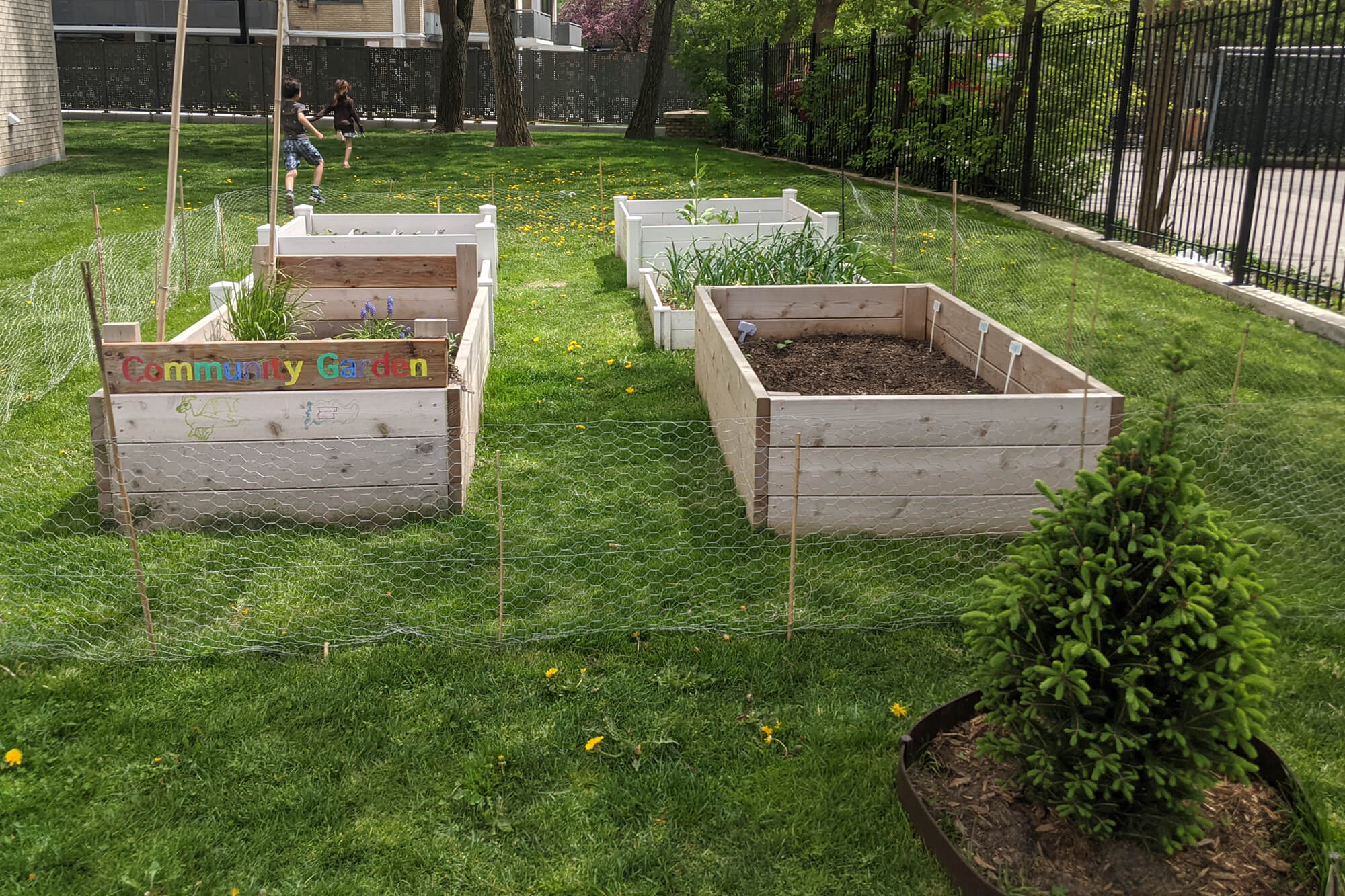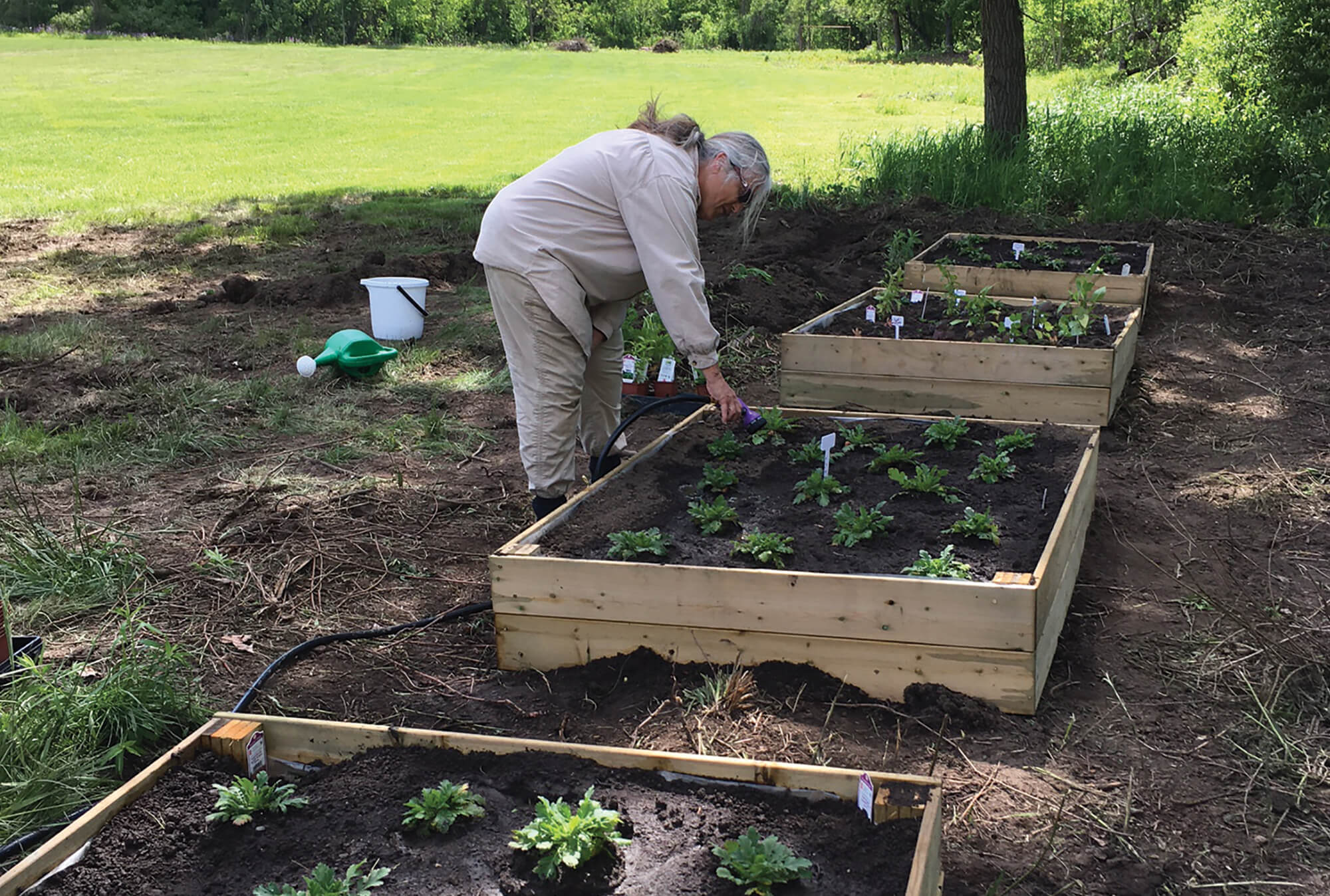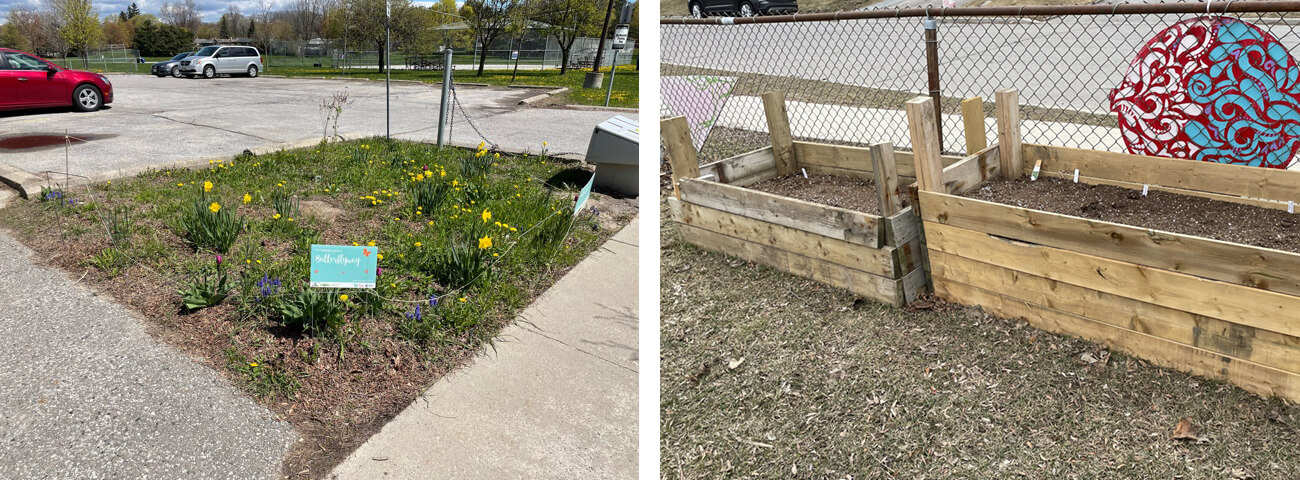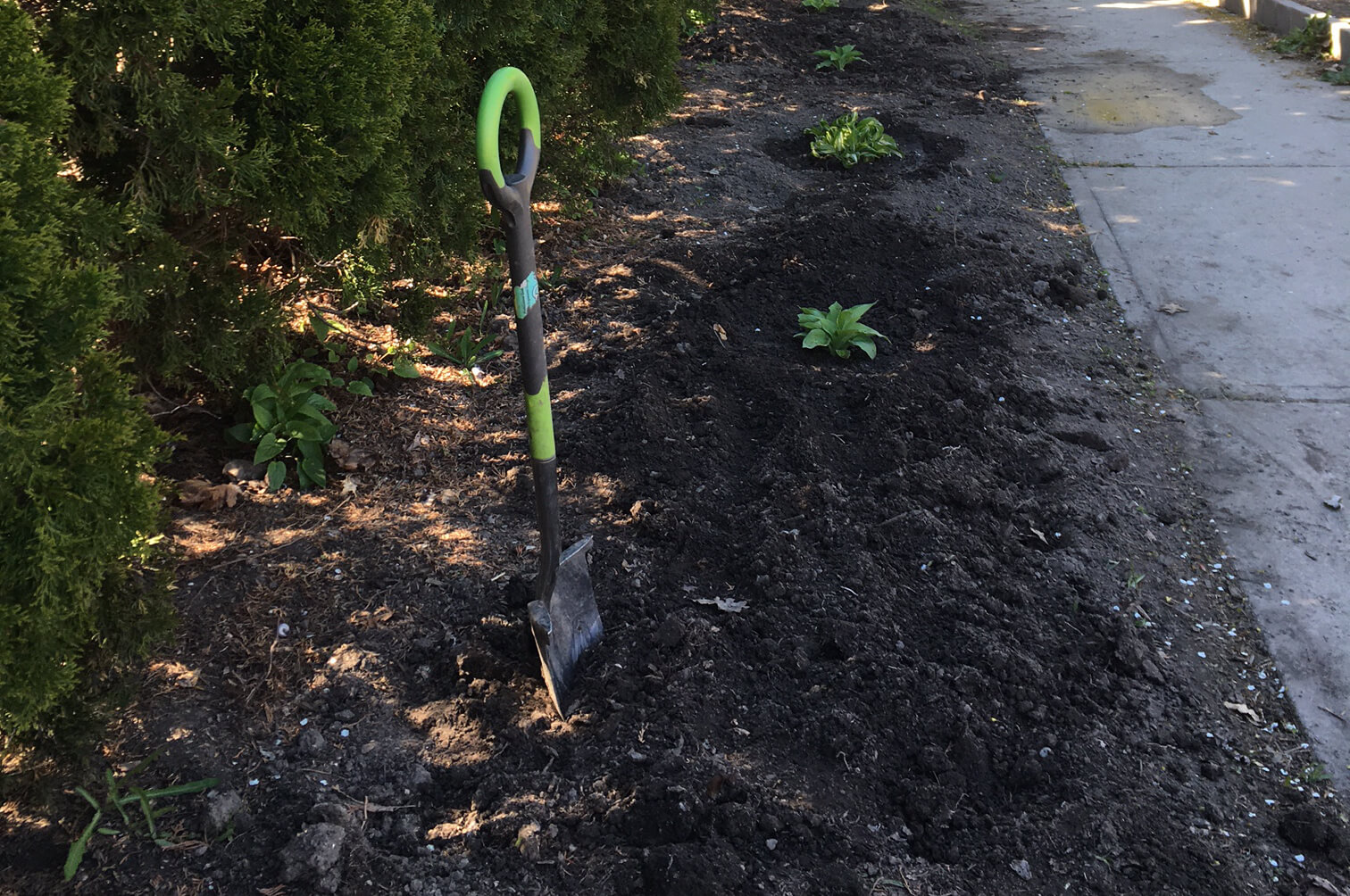July 6, 2021

St. George Community Garden, Toronto, Ont.
Toronto Chapter Bursary supports worthy community projects
By Taniya Spolia
What began as a one-time project to develop an accessible playground for handicapped children has now become a long-standing tradition of supporting the horticulture community.
Every year, the Toronto Chapter of Landscape Ontario provides grants up to $15,000, with a maximum amount of $1,500 to any single recipient, with the hopes of fostering the growth of small community-based green projects.
“We depend on word of mouth to get applicants, and that’s never been a problem...as long as [applicants] have a plan, volunteers, permission for the project and things organized then we can give you something to help,” says board member Skai Leja.
Although the primary help comes in the form of funding, Leja also speaks towards taking this opportunity to connect the horticulture community — from amateurs to professionals.
“It would be great to put the thought out there that if you have a group, or hear of a group, in your neighbourhood that resonates with you — whether it’s a school yard or an outdoor space for seniors — then you have the opportunity to get involved,” explains Leja. “And I’m talking to you as a contractor or someone involved in Landscape Ontario, as a person to carry your expertise outside of professional involvement and into the community.”
Taking a small personal interest in groups that require support is one of the many ways to develop and encourage growth in the horticulture profession.
“Our members are very giving, for example the contributions towards the frontline workers gardens,” mentions Leja. “People are contributing time, materials...that’s why we like to share this information. These aspirations aren’t too hard to reach, it’s more of a matter of ‘oh, I didn’t know that’ or ‘I never knew that group is near me.’”
This year, community projects across the Greater Toronto Area have taken off through hard work, community diligence and support from the Toronto Chapter. In celebration of their accomplishments and the goal to sustain horticulture enthusiasm, this is what some have been up to. Putting community interest first, households have come together to create a beautiful shared urban garden at 280 St. George Street, in Toronto, Ont.
Putting community interest first, households have come together to create a beautiful shared urban garden at 280 St. George Street, in Toronto, Ont.
Nuri Chang, gardener and tenant, spearheaded the project four years ago when she went to property management and pitched the idea of a communal garden. Since then, with the support of the landlord, building staff, grants, volunteers and fellow tenants, she and her community have been able to expand the garden to include food, fedges and a pollinator garden.
“There are five households that are most actively engaged,” says fellow tenant and gardener Paul Overy. “I’m very grateful Nuri sparked this chance to create a community around a garden. It’s an opportunity for us to grow some of our own food and show others [living in the city] that it can be done.”
To avoid membership fees and asking community members to pay out-of-pocket, these gardeners rely heavily on grants to sustain their gardens.
“We have no budget,” says Chang. “In the first year I was able to get a little bit of pocket money that enabled us to buy some things to start off… as well as support from our property manager. Since then, [grants] help us with everything.”
“I want to stress how thankful we are,” adds Overy.
Looking forward, both hope to sustain the garden and also advocate that not all urban land should be concrete and impermeable. Instead they say, it has the potential to house food producing productive plants that can develop and build a sense of community.
Chang implores those who live in rental properties to check-in with their landlords and tenant base, mentioning “if people are willing to put in the time, then this can be done. The result is a beautiful and educational opportunity for people of all ages.”
With the right support, and facilities, projects like the St. George Street community garden show us that communities can truly do amazing things. The Italian Cultural Centre of Milton (ICCM) has been a long standing pillar of community support in the Halton region. In the past, they have been focused on a number of philanthropic initiatives, from donating to the Milton District Hospital Foundation, to using their commercial kitchen to provide food for at-need households.
The Italian Cultural Centre of Milton (ICCM) has been a long standing pillar of community support in the Halton region. In the past, they have been focused on a number of philanthropic initiatives, from donating to the Milton District Hospital Foundation, to using their commercial kitchen to provide food for at-need households.
Now, in tandem with Sustainable Milton — a grassroots organization that aims to promote sustainable living through education and community projects — the two groups are working to develop pollinator, community and memorial gardens on the ICCM grounds.
“Milton is a great community,” says Rosanna Conteduca, ICCM president. We have great organizations and it’s never just about ‘me, me, me.’ When we put these organizations together we create greatness and I think that’s what we have — greatness. [Our property] is there for our community to appreciate and really enjoy, not just a few members… it’s beautiful and underutilized.”
The natural beauty of the grounds spans over 15 acres. Community initiatives and maintenance are dependent on donations, fundraising events and grants — the latter of which has become even more important during the pandemic.
“Without the grants and support of our community, our members, and our donors… it wouldn’t be possible. We can’t have any of this without the funding and support to help our ideas fly,” explains Wendy Roberts, a board member of both teams.
Both organizations hope to expand their existing gardens and develop new ones to maximize the use of the land while engaging new community members in their efforts.
“As founding members are starting to get elderly, and fewer and fewer, we decided it was really important to bring in new people,” explains Conteduca.
Sustaining the land comes with sustaining their community.
“There’s a lot to learn… we need to teach and include as many different groups and ages as possible,” says Marsha Smith, Chair of Sustainable Milton. “Growing up, watching my dad fluttering around and spending hours [in the garden] has made me want to instill that love of being outdoors and enjoying nature in others.”
The gardens are to serve as a crossroad between generations, where transgenerational learning can flourish alongside plants and produce. With ever greater social awareness of the dangers of climate change, the topic of environmental stewardship is increasingly taught in primary school science classes. Paul Fernandez, a seventh and eighth grade science teacher at Anson Public School in Scarborough, Ont., aims to bring hands-on environmental learning opportunities to his students in the form of a pollinator garden.
With ever greater social awareness of the dangers of climate change, the topic of environmental stewardship is increasingly taught in primary school science classes. Paul Fernandez, a seventh and eighth grade science teacher at Anson Public School in Scarborough, Ont., aims to bring hands-on environmental learning opportunities to his students in the form of a pollinator garden.
“With elementary science, we talk a lot about global warming and the misuse of resources… it’s like ‘What can we do as individuals?’ — I think this [question] is why I want to do things like [the garden] with my students,” explains Fernandez.
The school’s pollinator garden is home to native species and pollinator plants. While it is currently in its early stages, with support from community members and grants, Fernandez hopes to see it’s continued development. From better quality soil to enlisting the help of landscape professionals, much work is still to be done.
“Ultimately we want to expand our pollinator garden program… get the materials to make something that is sustainable year to year,” says Fernandez. “Something that won’t get taken out by a lawn mower or trampled by bicycles… maybe we can add signage to make it clear that ‘this is important, please let it grow and mature.’”
Beyond having a beautiful space and being good environmental citizens, the garden serves as a foundation for students. Elementary school is often void of hands-on opportunities that may gear children toward an interest in the skilled trades.
“If I can give [a child] an introduction to some carpentry… building planter boxes, or get them interested in growing a garden then they might see themselves in [these fields],” explains Fernandez.
And so, through education and passion, students, teachers and community members of Anson Public School are showing the community what can be done with a little bit of knowledge and hard work. The Parkview Neighbourhood Garden sits in the heart of North York, Ont., spanning two-acres amid high-condo buildings and residential houses. Managed by 10 volunteers, it thrives under a shared community passion and appreciation. Two volunteers, Bonnie LaRue and Michel Klamph, describe the garden as an Oasis and escape from everyday life.
The Parkview Neighbourhood Garden sits in the heart of North York, Ont., spanning two-acres amid high-condo buildings and residential houses. Managed by 10 volunteers, it thrives under a shared community passion and appreciation. Two volunteers, Bonnie LaRue and Michel Klamph, describe the garden as an Oasis and escape from everyday life.
“[The gardens are] my therapy,” mentions LaRue. “A getaway… a work in progress.”
Abandoned for several years, only recently did a team come together to revitalize the area.
“I felt embarrassed for the people who lived across the road… who for many years were looking at a wild mess of a perennial garden. Ever since last year, they get to look at beauty,” says Klamph.
As public land, the area was initially cleared by the city, but the responsibility to cover operational expenses was left to the gardeners. The garden has been developed through volunteer work and donations. Grants, such as the one from the Toronto Chapter Bursary, gives them the opportunity to maintain a flourishing environment.
“I don’t even know where to begin,” says LaRue, “we sometimes need to replace tools, ones that have gotten very old or broken — just weren’t usable. All the seeds [Michel and her group] have to buy. You wouldn’t believe, for the vegetable garden, how they have to scrounge for free seeds and reuse them from [existing] plants.”
And what they get from the community, they like to give back — donating produce and funds from their garden market to food security programs. A garden in the works, LaRue and Klamph both hope to see young people continue to join and learn from this community initiative.
“To me, the most important thing is sustainability,” says LaRue. “All this work we’re doing this year… I hope, 10 or 15 years from now, we’re still able to walk through.”
What began as a one-time project to develop an accessible playground for handicapped children has now become a long-standing tradition of supporting the horticulture community.
Every year, the Toronto Chapter of Landscape Ontario provides grants up to $15,000, with a maximum amount of $1,500 to any single recipient, with the hopes of fostering the growth of small community-based green projects.
“We depend on word of mouth to get applicants, and that’s never been a problem...as long as [applicants] have a plan, volunteers, permission for the project and things organized then we can give you something to help,” says board member Skai Leja.
Although the primary help comes in the form of funding, Leja also speaks towards taking this opportunity to connect the horticulture community — from amateurs to professionals.
“It would be great to put the thought out there that if you have a group, or hear of a group, in your neighbourhood that resonates with you — whether it’s a school yard or an outdoor space for seniors — then you have the opportunity to get involved,” explains Leja. “And I’m talking to you as a contractor or someone involved in Landscape Ontario, as a person to carry your expertise outside of professional involvement and into the community.”
Taking a small personal interest in groups that require support is one of the many ways to develop and encourage growth in the horticulture profession.
“Our members are very giving, for example the contributions towards the frontline workers gardens,” mentions Leja. “People are contributing time, materials...that’s why we like to share this information. These aspirations aren’t too hard to reach, it’s more of a matter of ‘oh, I didn’t know that’ or ‘I never knew that group is near me.’”
This year, community projects across the Greater Toronto Area have taken off through hard work, community diligence and support from the Toronto Chapter. In celebration of their accomplishments and the goal to sustain horticulture enthusiasm, this is what some have been up to.
St. George Street Community Garden
 Putting community interest first, households have come together to create a beautiful shared urban garden at 280 St. George Street, in Toronto, Ont.
Putting community interest first, households have come together to create a beautiful shared urban garden at 280 St. George Street, in Toronto, Ont.Nuri Chang, gardener and tenant, spearheaded the project four years ago when she went to property management and pitched the idea of a communal garden. Since then, with the support of the landlord, building staff, grants, volunteers and fellow tenants, she and her community have been able to expand the garden to include food, fedges and a pollinator garden.
“There are five households that are most actively engaged,” says fellow tenant and gardener Paul Overy. “I’m very grateful Nuri sparked this chance to create a community around a garden. It’s an opportunity for us to grow some of our own food and show others [living in the city] that it can be done.”
To avoid membership fees and asking community members to pay out-of-pocket, these gardeners rely heavily on grants to sustain their gardens.
“We have no budget,” says Chang. “In the first year I was able to get a little bit of pocket money that enabled us to buy some things to start off… as well as support from our property manager. Since then, [grants] help us with everything.”
“I want to stress how thankful we are,” adds Overy.
Looking forward, both hope to sustain the garden and also advocate that not all urban land should be concrete and impermeable. Instead they say, it has the potential to house food producing productive plants that can develop and build a sense of community.
Chang implores those who live in rental properties to check-in with their landlords and tenant base, mentioning “if people are willing to put in the time, then this can be done. The result is a beautiful and educational opportunity for people of all ages.”
With the right support, and facilities, projects like the St. George Street community garden show us that communities can truly do amazing things.
Italian Cultural Centre of Milton and Sustainable Milton
 The Italian Cultural Centre of Milton (ICCM) has been a long standing pillar of community support in the Halton region. In the past, they have been focused on a number of philanthropic initiatives, from donating to the Milton District Hospital Foundation, to using their commercial kitchen to provide food for at-need households.
The Italian Cultural Centre of Milton (ICCM) has been a long standing pillar of community support in the Halton region. In the past, they have been focused on a number of philanthropic initiatives, from donating to the Milton District Hospital Foundation, to using their commercial kitchen to provide food for at-need households.Now, in tandem with Sustainable Milton — a grassroots organization that aims to promote sustainable living through education and community projects — the two groups are working to develop pollinator, community and memorial gardens on the ICCM grounds.
“Milton is a great community,” says Rosanna Conteduca, ICCM president. We have great organizations and it’s never just about ‘me, me, me.’ When we put these organizations together we create greatness and I think that’s what we have — greatness. [Our property] is there for our community to appreciate and really enjoy, not just a few members… it’s beautiful and underutilized.”
The natural beauty of the grounds spans over 15 acres. Community initiatives and maintenance are dependent on donations, fundraising events and grants — the latter of which has become even more important during the pandemic.
“Without the grants and support of our community, our members, and our donors… it wouldn’t be possible. We can’t have any of this without the funding and support to help our ideas fly,” explains Wendy Roberts, a board member of both teams.
Both organizations hope to expand their existing gardens and develop new ones to maximize the use of the land while engaging new community members in their efforts.
“As founding members are starting to get elderly, and fewer and fewer, we decided it was really important to bring in new people,” explains Conteduca.
Sustaining the land comes with sustaining their community.
“There’s a lot to learn… we need to teach and include as many different groups and ages as possible,” says Marsha Smith, Chair of Sustainable Milton. “Growing up, watching my dad fluttering around and spending hours [in the garden] has made me want to instill that love of being outdoors and enjoying nature in others.”
The gardens are to serve as a crossroad between generations, where transgenerational learning can flourish alongside plants and produce.
Anson Public School Pollinator Garden
 With ever greater social awareness of the dangers of climate change, the topic of environmental stewardship is increasingly taught in primary school science classes. Paul Fernandez, a seventh and eighth grade science teacher at Anson Public School in Scarborough, Ont., aims to bring hands-on environmental learning opportunities to his students in the form of a pollinator garden.
With ever greater social awareness of the dangers of climate change, the topic of environmental stewardship is increasingly taught in primary school science classes. Paul Fernandez, a seventh and eighth grade science teacher at Anson Public School in Scarborough, Ont., aims to bring hands-on environmental learning opportunities to his students in the form of a pollinator garden.“With elementary science, we talk a lot about global warming and the misuse of resources… it’s like ‘What can we do as individuals?’ — I think this [question] is why I want to do things like [the garden] with my students,” explains Fernandez.
The school’s pollinator garden is home to native species and pollinator plants. While it is currently in its early stages, with support from community members and grants, Fernandez hopes to see it’s continued development. From better quality soil to enlisting the help of landscape professionals, much work is still to be done.
“Ultimately we want to expand our pollinator garden program… get the materials to make something that is sustainable year to year,” says Fernandez. “Something that won’t get taken out by a lawn mower or trampled by bicycles… maybe we can add signage to make it clear that ‘this is important, please let it grow and mature.’”
Beyond having a beautiful space and being good environmental citizens, the garden serves as a foundation for students. Elementary school is often void of hands-on opportunities that may gear children toward an interest in the skilled trades.
“If I can give [a child] an introduction to some carpentry… building planter boxes, or get them interested in growing a garden then they might see themselves in [these fields],” explains Fernandez.
And so, through education and passion, students, teachers and community members of Anson Public School are showing the community what can be done with a little bit of knowledge and hard work.
Parkview Neighbourhood Garden
 The Parkview Neighbourhood Garden sits in the heart of North York, Ont., spanning two-acres amid high-condo buildings and residential houses. Managed by 10 volunteers, it thrives under a shared community passion and appreciation. Two volunteers, Bonnie LaRue and Michel Klamph, describe the garden as an Oasis and escape from everyday life.
The Parkview Neighbourhood Garden sits in the heart of North York, Ont., spanning two-acres amid high-condo buildings and residential houses. Managed by 10 volunteers, it thrives under a shared community passion and appreciation. Two volunteers, Bonnie LaRue and Michel Klamph, describe the garden as an Oasis and escape from everyday life.“[The gardens are] my therapy,” mentions LaRue. “A getaway… a work in progress.”
Abandoned for several years, only recently did a team come together to revitalize the area.
“I felt embarrassed for the people who lived across the road… who for many years were looking at a wild mess of a perennial garden. Ever since last year, they get to look at beauty,” says Klamph.
As public land, the area was initially cleared by the city, but the responsibility to cover operational expenses was left to the gardeners. The garden has been developed through volunteer work and donations. Grants, such as the one from the Toronto Chapter Bursary, gives them the opportunity to maintain a flourishing environment.
“I don’t even know where to begin,” says LaRue, “we sometimes need to replace tools, ones that have gotten very old or broken — just weren’t usable. All the seeds [Michel and her group] have to buy. You wouldn’t believe, for the vegetable garden, how they have to scrounge for free seeds and reuse them from [existing] plants.”
And what they get from the community, they like to give back — donating produce and funds from their garden market to food security programs. A garden in the works, LaRue and Klamph both hope to see young people continue to join and learn from this community initiative.
“To me, the most important thing is sustainability,” says LaRue. “All this work we’re doing this year… I hope, 10 or 15 years from now, we’re still able to walk through.”